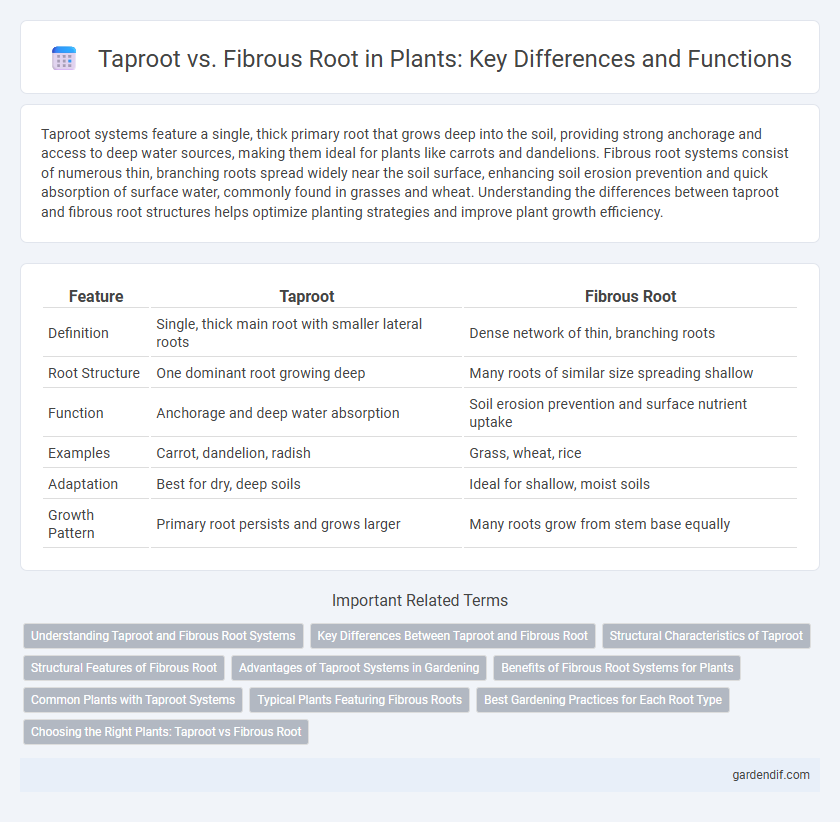
Taproot vs Fibrous root Illustration
Taproot systems feature a single, thick primary root that grows deep into the soil, providing strong anchorage and access to deep water sources, making them ideal for plants like carrots and dandelions. Fibrous root systems consist of numerous thin, branching roots spread widely near the soil surface, enhancing soil erosion prevention and quick absorption of surface water, commonly found in grasses and wheat. Understanding the differences between taproot and fibrous root structures helps optimize planting strategies and improve plant growth efficiency.
Table of Comparison
| Feature | Taproot | Fibrous Root |
|---|---|---|
| Definition | Single, thick main root with smaller lateral roots | Dense network of thin, branching roots |
| Root Structure | One dominant root growing deep | Many roots of similar size spreading shallow |
| Function | Anchorage and deep water absorption | Soil erosion prevention and surface nutrient uptake |
| Examples | Carrot, dandelion, radish | Grass, wheat, rice |
| Adaptation | Best for dry, deep soils | Ideal for shallow, moist soils |
| Growth Pattern | Primary root persists and grows larger | Many roots grow from stem base equally |
Understanding Taproot and Fibrous Root Systems
Taproot systems consist of a single, thick primary root that grows deep into the soil, anchoring the plant and accessing deep water sources, while fibrous root systems feature numerous thin roots spread out near the soil surface, maximizing nutrient absorption and preventing soil erosion. Taproots are common in dicots like carrots and dandelions, whereas fibrous roots dominate in monocots such as grasses and wheat. Understanding these root structures aids in selecting appropriate plant species for soil type, erosion control, and water availability management.
Key Differences Between Taproot and Fibrous Root
Taproots consist of a single, thick primary root that grows deep into the soil, providing strong anchorage and accessing deep water sources, while fibrous roots form a dense network of thin, shallow roots that spread horizontally near the soil surface, enhancing soil erosion control and nutrient absorption. Taproot systems are common in dicots such as carrots and dandelions, whereas fibrous root systems are typical in monocots like grasses and wheat. The structural difference impacts plant stability, resource acquisition, and adaptability to environmental conditions.
Structural Characteristics of Taproot
Taproots possess a central, thick primary root that grows vertically downward, providing strong anchorage and deeper access to water sources. Their structure features a dominant main root with smaller lateral roots branching off, enhancing nutrient absorption in deep soil layers. This root system is typical in dicots like carrots and dandelions, optimizing stability and drought resistance.
Structural Features of Fibrous Root
Fibrous roots consist of a dense network of thin, thread-like roots that spread out horizontally near the soil surface, providing excellent soil erosion control and stability. Unlike taproots, fibrous roots lack a dominant central root and have numerous similarly sized branches, enhancing water and nutrient absorption from the upper soil layers. This root structure is common in monocots such as grasses, facilitating rapid colonization and efficient resource uptake in shallow soils.
Advantages of Taproot Systems in Gardening
Taproot systems provide superior anchorage and stability, enabling plants to access deep water reserves and nutrients unavailable to surface roots. This deep penetration reduces drought stress and improves resilience in arid environments. Gardeners benefit from taproots by cultivating crops with enhanced nutrient uptake and sustained growth during dry periods.
Benefits of Fibrous Root Systems for Plants
Fibrous root systems enhance soil stabilization by forming dense networks that prevent erosion and improve water retention. These roots increase nutrient absorption efficiency through a widespread structure, fostering better growth in shallow soils. The rapid regeneration of fibrous roots allows plants to quickly recover from environmental stress and damage.
Common Plants with Taproot Systems
Carrots, dandelions, and radishes are common plants with taproot systems, characterized by a single, thick primary root that grows deep into the soil for maximum water absorption and stability. These taproots store nutrients efficiently, aiding in plant survival during drought or poor soil conditions. Unlike fibrous root systems found in grasses, taproots provide strong anchorage and access to deeper soil layers.
Typical Plants Featuring Fibrous Roots
Typical plants featuring fibrous roots include grasses, wheat, rice, and maize, which develop dense, branching root systems spreading horizontally near the soil surface. These fibrous roots enhance soil erosion control and improve nutrient absorption efficiency by increasing root surface area compared to taproot systems found in plants like carrots and dandelions. This root structure supports rapid water uptake and stability in shallow soils, making fibrous roots ideal for monocotyledonous plants and many herbaceous species.
Best Gardening Practices for Each Root Type
Taproot systems, characterized by a dominant central root, benefit from deep, well-drained soil to encourage vertical growth and access to deep water reserves. Fibrous roots, consisting of a dense network of fine roots, thrive in loose, nutrient-rich topsoil with frequent shallow watering to enhance surface nutrient absorption. Proper soil preparation and tailored watering schedules optimize plant health by supporting the specific water and nutrient uptake mechanisms of each root type.
Choosing the Right Plants: Taproot vs Fibrous Root
Choosing the right plants depends on understanding the differences between taproot and fibrous root systems. Taproot plants, like carrots and dandelions, develop a single, deep primary root ideal for reaching deep water sources and anchoring firmly in loose soils. Fibrous root plants, such as grasses and wheat, have a dense network of shallow roots that efficiently prevent soil erosion and rapidly absorb surface moisture.
Taproot vs Fibrous root Infographic

 gardendif.com
gardendif.com